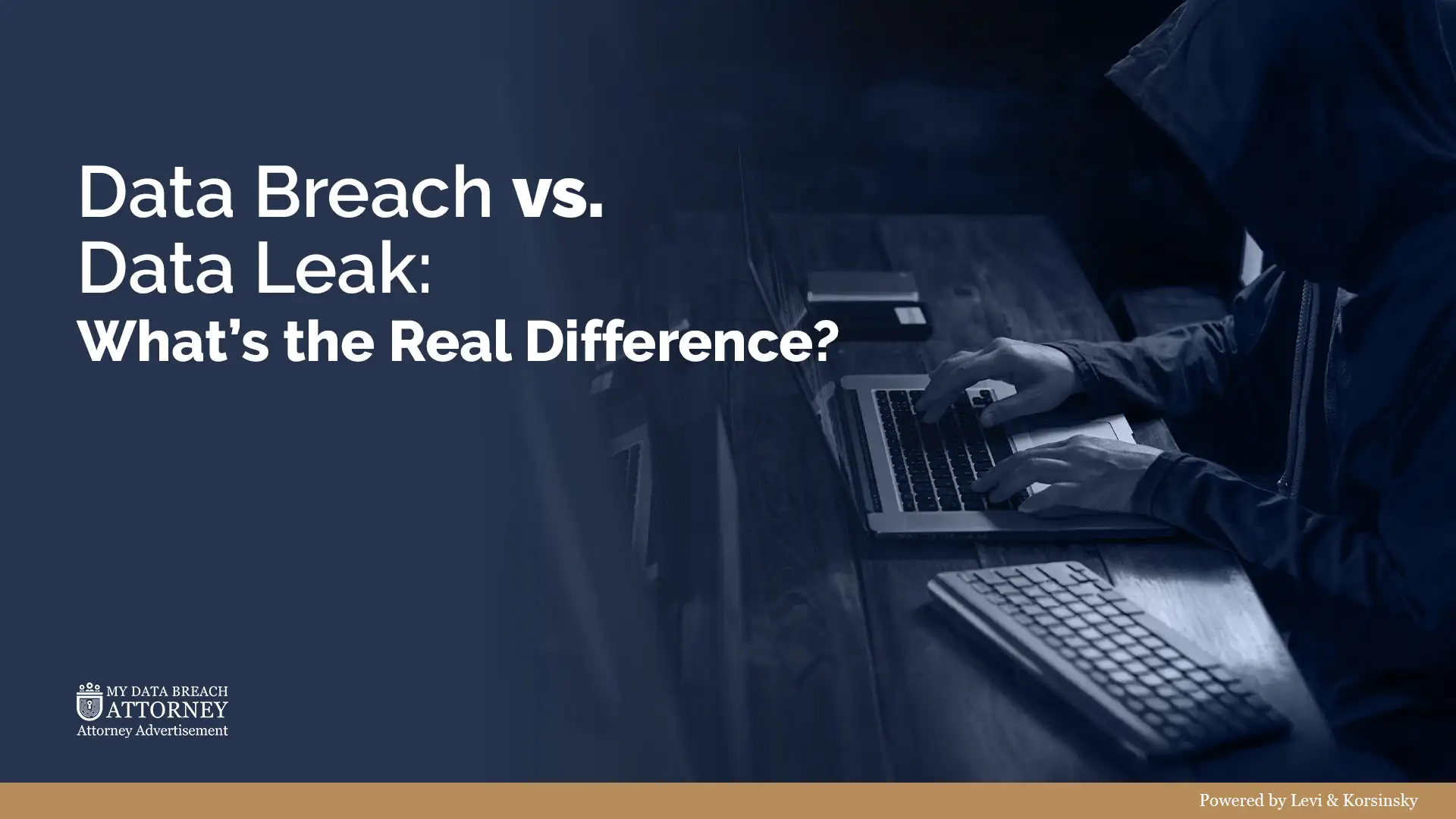Data breaches are serious events in which malicious actors, often targeting insufficiently secured company systems, expose the sensitive information of hundreds to millions of people. You may also have heard about “data leaks.”
While these terms might be used interchangeably in a casual context, they in fact reference two different kinds of security incidents. Knowing the difference is not simply a matter of semantics, it’s knowing the threat to your privacy, knowing your rights under the law, and knowing how to take the appropriate action to safeguard yourself.
In plain language: a data leak tends to be an unintentional exposure. A data breach is the result of an intentional attack. One is like forgetting to lock your front door; the other is like someone picking the lock.
Now, let’s dive in and learn what is the difference between a data breach vs. data leak.
At a Glance: Data Breach vs Data Leak — The Core Differences
| Data Leak | Data Breach | |
| Cause | Internal Error | External Attack (or malicious insider) |
| Intent | Unintentional | Intentional |
| How it happens | Misconfigured database, lost device, accidental email | Hacking, phishing, malware, ransomware |
| Speed of Discovery | Can be slow; may be found by researchers | Often rapid due to system alerts or attacker boasts |
| Primary Goal | None; it’s a mistake | Theft, fraud, espionage, or sabotage |
Recent real-world examples include healthcare incidents like the Archer Health Data Breach and brokerage and financial investment services sector incidents such as the MoneyBlock data breach.
What is a Data Leak? (An Unintentional Exposure)
A data leak occurs when sensitive data is accidentally exposed to the public, either online or through lost physical assets. There is no malicious attacker involved. The exposure is caused by an internal mistake, oversight, or negligence.
Think of a data leak as a slow drip from a pipe. The water (your data) is escaping, but no one deliberately broke the pipe.
Common Causes of Data Leaks:
- Misconfigured Cloud Storage: An employee sets an Amazon S3 bucket or Azure database to “public” instead of “private,” leaving it open for anyone on the internet to find and access.
- Misdelivered Information: Sending an email containing sensitive personal information to the wrong person.
- Lost or Stolen Devices: Someone leaves an unencrypted company laptop or USB drive containing customer data in a taxi.
- Software Bugs: A programming error in an app or website accidentally displays one user’s data to another logged-in user.
For example, suppose a marketing agency creates a public-facing webpage to showcase its work. By mistake, they upload a spreadsheet that includes a client list with names, email addresses, and phone numbers. This file is now accessible to anyone who guesses the URL. The data was leaked due to human error.
What is a Data Breach? (A Deliberate Attack)
A data breach is a deliberate, malicious event where a cybercriminal successfully bypasses security measures to illegally access, steal, or expose confidential information. The key element here is intent.
Think of a data breach as a bank heist. Criminals carefully plan, use tools to defeat security systems, and intentionally steal the money (your data).
Common Causes of Data Breaches:
- Phishing Attacks: Deceptive emails trick employees into revealing login credentials.
- Malware & Ransomware: Malicious software is installed on a network to steal data or hold it hostage.
- Hacking: Exploiting vulnerabilities in software or systems to gain unauthorized access.
- Credential Stuffing: Using username/password pairs from previous breaches to break into other accounts where people reused passwords.
- Malicious Insiders: A disgruntled employee with authorized access deliberately steals and exposes data.
Take this scenario for an example, hackers discover a vulnerability in a company’s website that wasn’t patched. They use this flaw to install malware that scrapes the entire customer database, including names, addresses, and credit card numbers. They then sell this data on the dark web. This is a deliberate data breach.
Which One is Worse?
While both are serious, a data breach is typically more dangerous in the immediate term.
- A Data Leak is a critical failure of data handling. While the data is exposed, it may not have been found or stolen by criminals yet. The risk is high, but the immediate threat can often be contained by quickly fixing the error. However, the exposed data can be discovered and exploited at any time.
- A Data Breach means malicious actors already have your data. They are actively using it for identity theft, financial fraud, phishing schemes, or other crimes. The damage is already in motion. As we’ve detailed in our guide on what to do after a data breach, the response needs to be immediate and comprehensive.
The Legal Implications: Why the Difference Matters
The distinction between a leak and a breach has significant legal consequences, primarily concerning notification laws.
In the United States, all 50 states have data breach notification laws. These laws vary but generally require organizations to notify affected individuals within the state if their unencrypted personal information was acquired, or reasonably believed to have been acquired, by an unauthorized person.
- For a Data Breach: Notification is almost always legally required because the “acquisition” of data by a malicious actor is clear. Stealing sensitive information is the very reason that criminals
.
- For a Data Leak: The legal requirement to notify may be less clear-cut if the company can demonstrate that the accidentally exposed data was unlikely to have been accessed or acquired by anyone. However, modern interpretations and regulations like HIPAA and the GDPR tend to err on the side of caution, often requiring notification for significant leaks as well.
A company can be held legally responsible for both incidents if negligence is proven. For example, failing to encrypt devices or implement basic security training could make a company liable for the damages resulting from a leak. You can learn more about this in our article on what constitutes a data breach.
Can a Leak Become a Breach?
Absolutely. This is a critical point. A data leak that goes unnoticed or unaddressed is a sitting duck for cybercriminals. Security researchers or automated scanning tools used by hackers often find publicly exposed data. Once they find it, they can easily download and exploit it, effectively turning an accidental leak into a malicious breach.
How to Protect Yourself
Whether it’s a leak or a breach, your personal information is exposed. Your response should be similar:
- Use a Password Manager: Create strong, unique passwords for every online account. This prevents credential stuffing attacks.
- Enable Multi-Factor Authentication (MFA): This adds a critical second layer of security to your accounts.
- Monitor Financial Accounts: Regularly check your bank and credit card statements for unauthorized transactions.
- Place a Credit Freeze: This is the most effective way to stop anyone from opening new accounts in your name.
- Be Wary of Phishing: Assume scammers have your data. Be extra cautious with emails, texts, or calls asking for personal information.
For a full list of steps, the FTC’s data security guide, is an excellent resource for consumers and businesses alike.
FAQ’s
Data leakage is the accidental exposure of data due to an internal error or oversight, like a misconfigured server. A data breach is the intentional access and theft of data by a malicious external actor or insider, achieved through a cyberattack like hacking or phishing.
No. “Hacked” implies a deliberate attack to bypass security, which defines a data breach. A data leak happens when someone exposes data by mistake, not when hackers breach systems. However, hackers can still find and exploit the leaked data.
A data breach is typically more immediately dangerous because it confirms criminals have your data and intend to use it maliciously. A data leak remains very serious because it exposes data that attackers can find and exploit at any time, turning it into a breach.
Yes. Companies have a legal duty to protect consumer data. If a company negligently fails to implement basic security measures or train employees, various state laws and regulations can hold it liable for the resulting damages.
Your response is largely the same for both: take steps to protect your identity. Assume your data is in the wild. Change passwords on affected accounts, enable multi-factor authentication, monitor your credit, and consider a credit freeze. The main difference is that a breach notice often comes with offered credit monitoring services.
Yes. This is a major risk. If cybercriminals discover an accidentally leaked database before the company does, they will download and steal the data, instantly turning the innocent leak into a malicious data breach.
You can’t prevent them at the source, but you can minimize the impact. Use unique passwords and a password manager, enable multi-factor authentication (MFA) on every account, and freeze your credit with all three major bureaus. This makes stolen data much harder for criminals to use.









